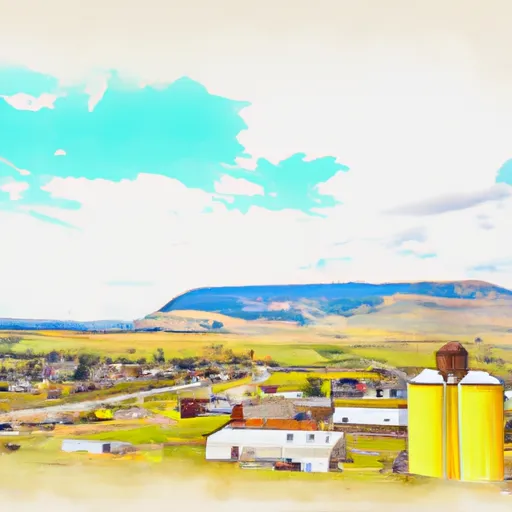-
 Snoflo Premium
Snoflo Premium
Get unlimited access to all our content
With no Ad interruptions! - Start Your Free Trial Login with existing account
Pony
Eden Index
Climate
6.9
•
Recreation
5.9
•
Community
•
Safeguard
4.9/10

Pony, Montana is a small town nestled in the Tobacco Root Mountains. It experiences a semi-arid climate, with hot summers and cold winters. Summers are generally dry and warm, with average temperatures around 80°F (27°C), while winters are cold, with average temperatures around 20°F (-7°C). The region receives an average annual precipitation of 15 inches, mostly in the form of snow during the winter months.
The town is surrounded by pristine natural beauty, with rivers and streams flowing through the area. The hydrology constituents of Pony include the North Willow Creek and Willow Creek, which provide opportunities for fishing, kayaking, and rafting. These waterways are known for their abundance of trout, offering outdoor enthusiasts an angler's paradise.
In addition to water-based activities, Pony offers several other outdoor recreation opportunities. The nearby mountains provide ample opportunities for hiking, camping, and wildlife viewing. The area is also popular for hunting during the appropriate seasons. With its picturesque landscapes and diverse wildlife, Pony, Montana, is a haven for nature lovers and outdoor enthusiasts seeking to immerse themselves in the beauty of the region.
What is the Eden Index?
The Snoflo Eden Index serves as a comprehensive rating system for regions, evaluating their desirability through a holistic assessment of climate health, outdoor recreation opportunities, and natural disaster risk, acknowledging the profound impact of these factors on livability and well-being.
Climate Health Indicator (CHI): 6.9
Pony receives approximately
490mm of rain per year,
with humidity levels near 63%
and air temperatures averaging around
6°C.
Pony has a plant hardyness factor of
4, meaning
plants and agriculture in this region thrive during a short period during spring and early summer. Most
plants will die off during the colder winter months.
By considering the ideal temperature range, reliable water supplies, clean air, and stable seasonal rain or snowpacks, the Climate Health Indicator (CHI) underscores the significance of a healthy climate as the foundation for quality living.
A healthy climate is paramount for ensuring a high quality of life and livability in a region, fostering both physical well-being and environmental harmony. This can be characterized by ideal temperatures, reliable access to water supplies, clean air, and consistent seasonal rain or snowpacks.
Weather Forecast
Streamflow Conditions
Missouri Headwaters
Area Rivers
Missouri Headwaters
Snowpack Depths
Missouri Headwaters
Reservoir Storage Capacity
Missouri Headwaters
Groundwater Levels
Recreational Opportunity Index (ROI): 5.9
The Recreational Opportunity Index (ROI) recognizes the value of outdoor recreational options, such as parks, hiking trails, camping sites, and fishing spots, while acknowledging that climate plays a pivotal role in ensuring the comfort and consistency of these experiences.
Access to outdoor recreational opportunities, encompassing activities such as parks, hiking, camping, and fishing, is crucial for overall well-being, and the climate plays a pivotal role in enabling and enhancing these experiences, ensuring that individuals can engage in nature-based activities comfortably and consistently.
Camping Areas
| Campground | Campsites | Reservations | Toilets | Showers | Elevation |
|---|---|---|---|---|---|
| Branham Lakes | 6 | 8,791 ft | |||
| Potosi | 14 | 6,232 ft | |||
| Lewis and Clark Caverns State Park | 40 | 4,270 ft | |||
| Balanced Rock | 5 | 7,341 ft | |||
| Mill Creek | 10 | 6,509 ft | |||
| Harrison Lake FAS | 12 | 4,743 ft |
Nearby Ski Areas
Catastrophe Safeguard Index (CSI):
The Catastrophe Safeguard Index (CSI) recognizes that natural disaster risk, encompassing floods, fires, hurricanes, and tornadoes, can drastically affect safety and the overall appeal of an area.
The level of natural disaster risk in a region significantly affects safety and the overall livability, with climate change amplifying these risks by potentially increasing the frequency and intensity of events like floods, fires, hurricanes, and tornadoes, thereby posing substantial challenges to community resilience and well-being.
Community Resilience Indicator (CRI):
The Community Resilience Indicator (CRI) recognizes that education, healthcare, and socioeconomics are crucial to the well-being of a region. The CRI acknowledges the profound impact of these elements on residents' overall quality of life. By evaluating educational resources, healthcare accessibility, and economic inclusivity, the index captures the essential aspects that contribute to a thriving community, fostering resident satisfaction, equity, and social cohesion.

